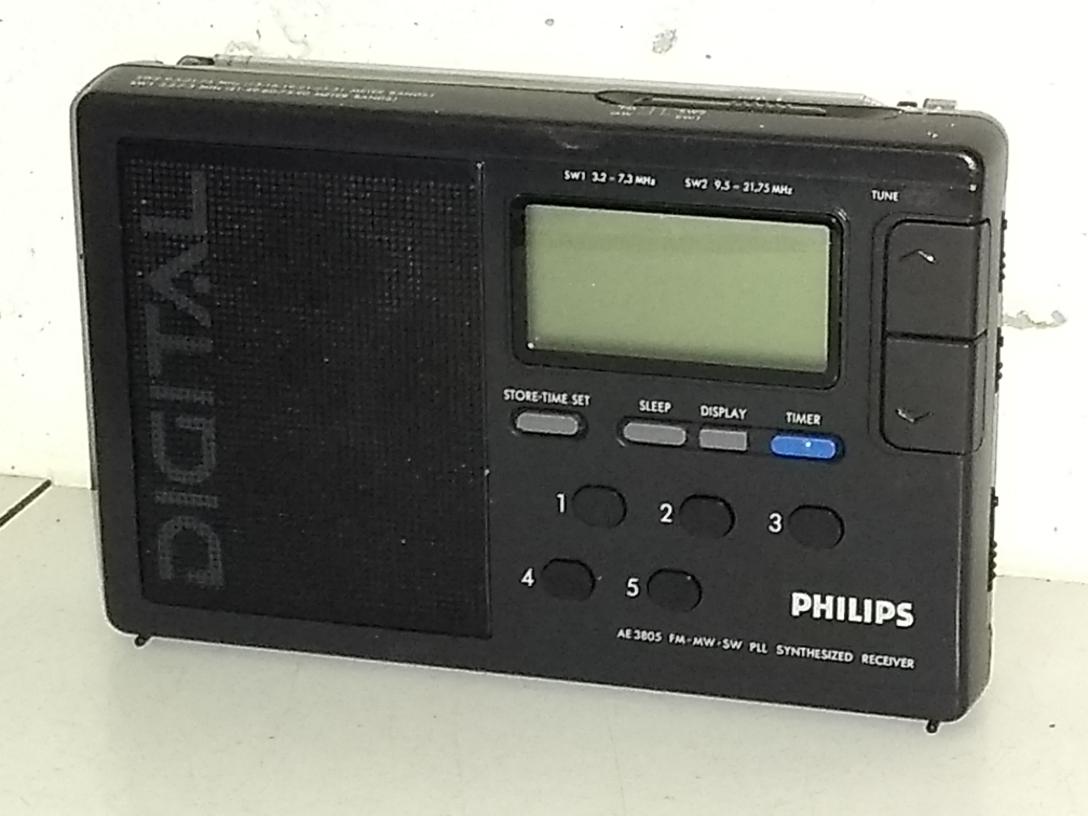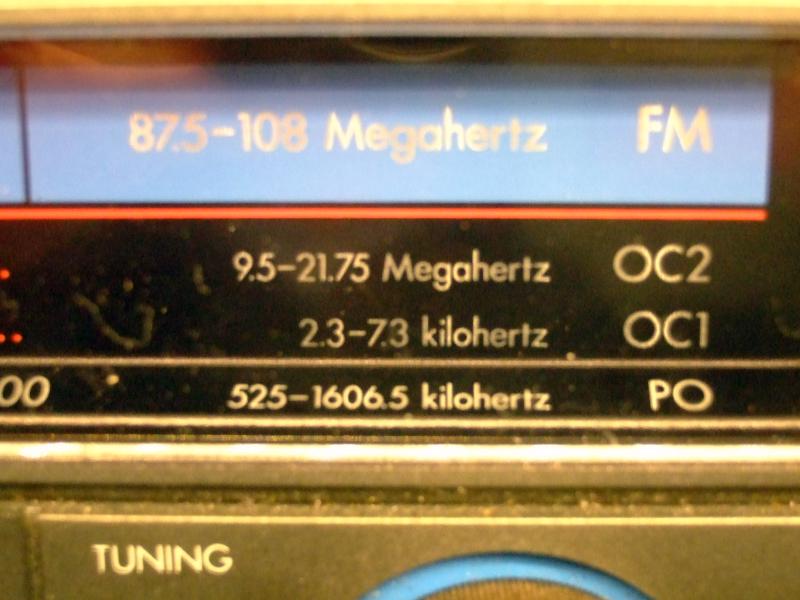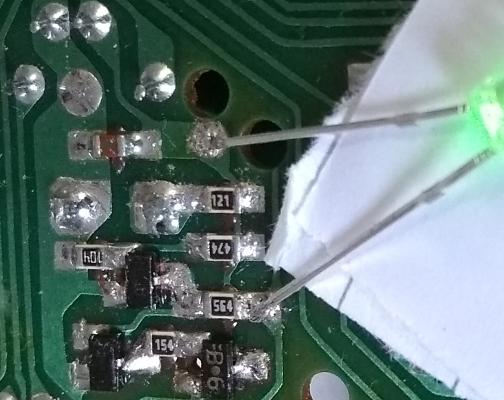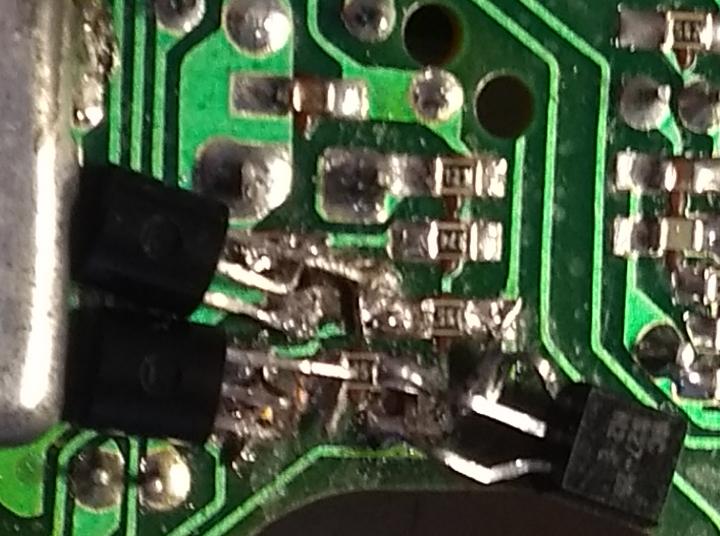
522
Item nr.

Philips AE3805 Portable
Digital travel companion.
Data for Philips AE3805
| Production | Taiwan, 2000.
|
|---|
| Bands | MW (531-1602kHz), SW1 (3.2-7.3MHz), SW2 (9.5-21.75MHz), FM (87.5-108MHz). |
|---|
| Cabinet | Plastic.
Size 17x11x3.5cm.
|
|---|
| Power | 6V Batt or adapter. |
|---|
| Documents | Service docs, Manual. |
|---|
The Design
Analogue radios are still found in shops, but digital became the standard for main stream models decades ago. Travel radios got digitized in the nineties.  I think the typical Philips Tropical bandplan was inspired by limitations of analogue tuning. Indeed, with a tuning capacitor, a band can stretch about a 1:3 ratio between low and high limit. So, the Philips D2243 of 1985 had SW1 from 2.3 to 7.3MHz, and SW2 starting at 9.5MHz. Observe the full coverage of all Tropical and Short Wave bands, and the gap between the 41m and 31m bands. This radio, while the tuning is completely digital and control by a microprocessor, follows the same band coverage.
I think the typical Philips Tropical bandplan was inspired by limitations of analogue tuning. Indeed, with a tuning capacitor, a band can stretch about a 1:3 ratio between low and high limit. So, the Philips D2243 of 1985 had SW1 from 2.3 to 7.3MHz, and SW2 starting at 9.5MHz. Observe the full coverage of all Tropical and Short Wave bands, and the gap between the 41m and 31m bands. This radio, while the tuning is completely digital and control by a microprocessor, follows the same band coverage.
| Obtained | 9/2020
from Snuffelmarkt Doorn. |
|---|
| Condition | 9; fully operational, no scratches, no box. |
|---|
| Disposed | Sold 8/2021. |
|---|
This Object
The radio was unfortunately completely dead.

 Complete failure is most probably due to an error in the power supply. The battery or adapter charges a main capacitor C74, the voltage there was OK. (C74 is drawn reversed polarised in the drawing, and so is the DC plug, because it has minus on the centerpin.) However, on the 3V capacitor C71 and backup capacitor C72, I found zero. A bridge between C74 and C71, formed by a green LED with drop voltage 2.5V, charged C71 and brought the radio back to life. As shown in the schema, this charging continues even when the unit is switched off, of course to supply the clock and memory, and the radio suffers a vampire drain of about 250µA. This means that a set of AA batteries, with capacity say 3000mAh, is depleted after about one and a half year.
Complete failure is most probably due to an error in the power supply. The battery or adapter charges a main capacitor C74, the voltage there was OK. (C74 is drawn reversed polarised in the drawing, and so is the DC plug, because it has minus on the centerpin.) However, on the 3V capacitor C71 and backup capacitor C72, I found zero. A bridge between C74 and C71, formed by a green LED with drop voltage 2.5V, charged C71 and brought the radio back to life. As shown in the schema, this charging continues even when the unit is switched off, of course to supply the clock and memory, and the radio suffers a vampire drain of about 250µA. This means that a set of AA batteries, with capacity say 3000mAh, is depleted after about one and a half year.

 The parts are all very small, but I managed to replace T12 and T13 bij BC547, unfortunately without effect. Next I replaced T11 by BC327, and then the radio worked again. It was suggested in the Transistorforum that vampire draw could be reduced by replacing R38 by a diode, which I did. The 3V-circuit now carries 2.95V, and the vampire current is about 70µA (so, the same set of AA batteries will supply the clock for almost five years). Fortunately, the cabinet has sufficient space to house the bigger transistors. The radio is now again fully functional and looks very clean and undamaged.
The parts are all very small, but I managed to replace T12 and T13 bij BC547, unfortunately without effect. Next I replaced T11 by BC327, and then the radio worked again. It was suggested in the Transistorforum that vampire draw could be reduced by replacing R38 by a diode, which I did. The 3V-circuit now carries 2.95V, and the vampire current is about 70µA (so, the same set of AA batteries will supply the clock for almost five years). Fortunately, the cabinet has sufficient space to house the bigger transistors. The radio is now again fully functional and looks very clean and undamaged.
Part of Gerard's Radio Corner.
Generated by SiteBuilder on
26/2/2024
by Gerard
(g.tel@uu.nl)
 I think the typical Philips Tropical bandplan was inspired by limitations of analogue tuning. Indeed, with a tuning capacitor, a band can stretch about a 1:3 ratio between low and high limit. So, the Philips D2243 of 1985 had SW1 from 2.3 to 7.3MHz, and SW2 starting at 9.5MHz. Observe the full coverage of all Tropical and Short Wave bands, and the gap between the 41m and 31m bands. This radio, while the tuning is completely digital and control by a microprocessor, follows the same band coverage.
I think the typical Philips Tropical bandplan was inspired by limitations of analogue tuning. Indeed, with a tuning capacitor, a band can stretch about a 1:3 ratio between low and high limit. So, the Philips D2243 of 1985 had SW1 from 2.3 to 7.3MHz, and SW2 starting at 9.5MHz. Observe the full coverage of all Tropical and Short Wave bands, and the gap between the 41m and 31m bands. This radio, while the tuning is completely digital and control by a microprocessor, follows the same band coverage.



 Complete failure is most probably due to an error in the power supply. The battery or adapter charges a main capacitor C74, the voltage there was OK. (C74 is drawn reversed polarised in the drawing, and so is the DC plug, because it has minus on the centerpin.) However, on the 3V capacitor C71 and backup capacitor C72, I found zero. A bridge between C74 and C71, formed by a green LED with drop voltage 2.5V, charged C71 and brought the radio back to life. As shown in the schema, this charging continues even when the unit is switched off, of course to supply the clock and memory, and the radio suffers a vampire drain of about 250µA. This means that a set of AA batteries, with capacity say 3000mAh, is depleted after about one and a half year.
Complete failure is most probably due to an error in the power supply. The battery or adapter charges a main capacitor C74, the voltage there was OK. (C74 is drawn reversed polarised in the drawing, and so is the DC plug, because it has minus on the centerpin.) However, on the 3V capacitor C71 and backup capacitor C72, I found zero. A bridge between C74 and C71, formed by a green LED with drop voltage 2.5V, charged C71 and brought the radio back to life. As shown in the schema, this charging continues even when the unit is switched off, of course to supply the clock and memory, and the radio suffers a vampire drain of about 250µA. This means that a set of AA batteries, with capacity say 3000mAh, is depleted after about one and a half year. 
 The parts are all very small, but I managed to replace T12 and T13 bij BC547, unfortunately without effect. Next I replaced T11 by BC327, and then the radio worked again. It was suggested in the
The parts are all very small, but I managed to replace T12 and T13 bij BC547, unfortunately without effect. Next I replaced T11 by BC327, and then the radio worked again. It was suggested in the